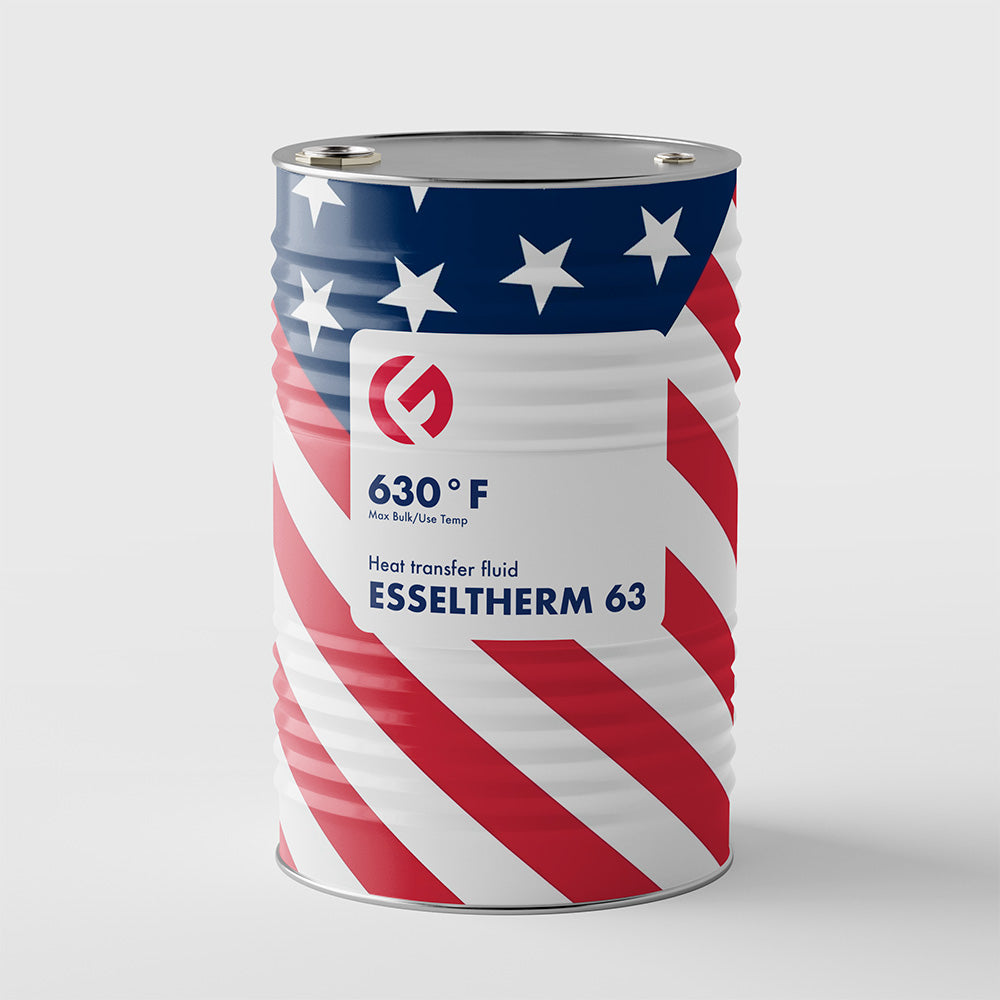Heat transfer fluid ESSELTHERM 63
Heat transfer fluid ESSELTHERM 63
Description
With a rating of up to 333°C (630°F), ESSELTHERM 63 is designed as an economical, environmentally friendly alternative to traditional chemical aromatic thermal fluids. Its advanced formulation ensures years of reliable service, providing superior protection against oxidation even at elevated temperatures. This thermal heating fluid offers exceptional performance, making it ideal for applications requiring durability and efficiency in high-temperature operations.
Key features
- Maximum operating temperature of 333°C (630°F)
- A clean and efficient alternative to synthetic, benzene-based thermal fluids
- Designed for precise and accurate temperature regulation
- Helps lubricate and prolong the lifespan of gaskets and seals
- Provides exceptional protection against sludge buildup
- Non-toxic and non-hazardous for safer use
Specifications
Temperate ratings
| Max Bulk/Use Temp | 630°F |
| Max Film Temp. | 670°F |
| Pour Point ASTM D445 | -1°F |
Safety data
| Flash Point ASTM D92 | 444°F |
| Fire Point ASTM D92 | 472°F |
| Autoignition ASTM E-659-78 | 692°F |
Thermal properties
| Thermal Expansion Coefficient | 0.0562 %/°F |
| Thermal Conductivity 100°F | 0.083 BTU/hr·ft·F° |
| Thermal Conductivity 212°F | 0.081 BTU/hr·ft·F° |
| Thermal Conductivity 399°F | 0.078 BTU/hr·ft·F° |
| Thermal Conductivity 500°F | 0.076 BTU/hr·ft·F° |
| Thermal Conductivity 550°F | 0.075 BTU/hr·ft·F° |
| Thermal Conductivity 630°F | 0.073 BTU/hr·ft·F° |
| Heat Capacity 100°F | 0.475 BTU/lb·F° |
| Heat Capacity 212°F | 0.524 BTU/lb·F° |
| Heat Capacity 399°F | 0.606 BTU/lb·F° |
| Heat Capacity 500°F | 0.65 BTU/lb·F° |
| Heat Capacity 550°F | 0.672 BTU/lb·F° |
| Heat Capacity 630°F | 0.707 BTU/lb·F° |
Physical properties
| Viscosity ASTM D445 40°F | 320.56 cSt |
| Viscosity ASTM D445 100°F | 46.66 cSt |
| Viscosity ASTM D445 260°F | 4.15 cSt |
| Density ASTM D1298 100°F | 53.29 lb/ft³ |
| Density ASTM D1298 212°F | 50.64 lb/ft³ |
| Density ASTM D1298 399°F | 46.23 lb/ft³ |
| Density ASTM D1298 500°F | 43.85 lb/ft³ |
| Density ASTM D1298 550°F | 42.68 lb/ft³ |
| Density ASTM D1298 630°F | 40.79 lb/ft³ |
| Vapor Pressure ASTM D2879 100°F | 0 psia |
| Vapor Pressure ASTM D2879 212°F | 0 psia |
| Vapor Pressure ASTM D2879 399°F | 0.06 psia |
| Vapor Pressure ASTM D2879 500°F | 0.33 psia |
| Vapor Pressure ASTM D2879 550°F | 0.71 psia |
| Vapor Pressure ASTM D2879 630°F | 2.04 psia |
| Distillation Range ASTM D2887 10% | 721°F |
| Distillation Range ASTM D2887 90% | 921°F |
| Molecular Weight | 395 |
| Specific Gravity @ 60°F | 0.864 |

Request a quote
Please provide as much detail as possible about your application and technical requirements, so we can offer the best solution for your needs.
FAQ
What is a Heat Transfer Fluid?
Heat transfer fluids are substances used to transfer heat from one location to another. They come in various types, each offering unique properties suitable for indirect heating or cooling of equipment like process reactors, molds, or extruders. They are also utilized in portable oil heaters and temperature control units. These fluids are sometimes referred to as thermal oil, thermal fluids, hot oil, or heat transfer oil.
Are all heat transfer fluids compatible with each other?
No, not all fluids are compatible. While most petroleum-based fluids are generally compatible, some glycol-based, aromatic chemical, or synthetic fluids may not be. It's important to consult your supplier's technical service department for recommendations. If you're switching from an incompatible fluid, ask your supplier for a compatible flushing fluid to avoid any issues.
How do I choose the right heat transfer fluid for my application?
Selecting the appropriate heat transfer fluid depends on several factors specific to your system and operational needs:
- Operating Temperature Range: Identify the minimum and maximum temperatures your system will encounter. Choose a fluid that performs efficiently within this range.
- System Type: Determine whether your system is open or closed, as some fluids are better suited for one type over the other.
- Compatibility: Ensure the fluid is compatible with your system's materials and any existing fluids to prevent corrosion or degradation.
- Thermal Stability: Opt for fluids with high thermal stability to minimize oxidation and extend the fluid's service life.
- Environmental and Safety Considerations: Consider the fluid's toxicity, flammability, and environmental impact, especially if spills or leaks are a concern.
- Maintenance Requirements: Some fluids may require more frequent monitoring or have specific maintenance protocols.
- Cost Effectiveness: Evaluate the total cost of ownership, including initial costs, maintenance, and potential disposal fees.
For personalized guidance tailored to your specific application, please contact ESSELTHERM technical support. Their experts can help you select the optimal heat transfer fluid to ensure efficient and reliable system performance.
How often should heat transfer fluids be changed?
The service life of heat transfer fluids varies based on their quality and the equipment they're used in. In extreme cases, a fluid might need to be changed after a few months; in other situations, it can last over ten years. The only way to accurately determine if your fluid is still effective is through specific laboratory analysis, a service your supplier should provide.
What makes one heat transfer fluid better than another?
The effectiveness of a heat transfer fluid depends on the system it's used in. Some fluids perform better in closed systems, while others excel in open systems such as those used in plastic processing. While the base stock of the fluid is important, the additives—like oxidation inhibitors and rust and corrosion preventatives—play a crucial role in extending the fluid's life. Using a fluid with the appropriate additives can keep your system running longer and cleaner between oil changes, especially if the system is open to the atmosphere.

